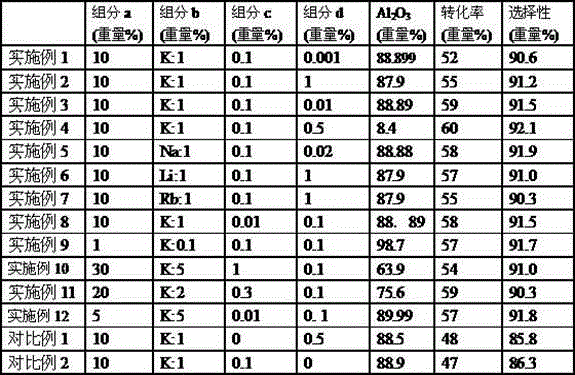Catalyst for dehydrogenating light alkane
A technology for dehydrogenation catalysts and low-carbon alkanes, which is applied in the direction of hydrocarbons, hydrocarbons, physical/chemical process catalysts, etc., and can solve the problem of low activity of low-carbon alkane dehydrogenation catalysts
- Summary
- Abstract
- Description
- Claims
- Application Information
AI Technical Summary
Problems solved by technology
Method used
Image
Examples
Embodiment 1
[0031]Weigh 52.65 grams of chromium nitrate, 2.15 grams of potassium nitrate, 0.07 grams of phosphoric acid, and 0.0027 grams of gallium nitrate, add them to 100 milliliters of deionized water, then add 88.899 grams of alumina carrier, adjust the pH value of the solution to 3.5 with 2.5% ammonia water, After soaking in a water bath at 80°C for 1 hour, the sample was taken out for filtration, dried in an oven at 120°C for 8 hours, and then put into a muffle furnace and roasted at 550°C for 4 hours to obtain the desired catalyst. Adjust the flow rate of propane gas through the mass flow meter, enter the preheating zone for mixing, and then enter the reaction zone. Both the preheating zone and the reaction zone of the reactor are heated by electric heating wires to make them reach the predetermined temperature. The inner diameter of the reactor is Ф9mm— Ф6mm stainless steel casing, about 400mm long. After the reaction gas passes through the condensation tank, it enters the gas ch...
Embodiment 2
[0035] Weigh 52.65 grams of chromium nitrate, 2.15 grams of potassium nitrate, 0.07 grams of phosphoric acid, and 2.7 grams of gallium nitrate, add them to 100 milliliters of deionized water, then add 86.5 grams of alumina carrier, adjust the pH value of the solution to 3.5 with 2.5% ammonia water, After soaking in a water bath at 80°C for 1 hour, the sample was taken out for filtration, dried in an oven at 120°C for 8 hours, and then put into a muffle furnace and roasted at 550°C for 4 hours to obtain the desired catalyst. Evaluation conditions are the same as in Example 1, and the results are shown in Table 1.
[0036]
Embodiment 3
[0038] Weigh 52.65 grams of chromium nitrate, 2.15 grams of potassium nitrate, 0.07 grams of phosphoric acid, and 0.027 grams of gallium nitrate, add them to 100 milliliters of deionized water, then add 87.499 grams of alumina carrier, adjust the pH value of the solution to 3.5 with 2.5% ammonia water, After soaking in a water bath at 80°C for 1 hour, the sample was taken out for filtration, dried in an oven at 120°C for 8 hours, and then put into a muffle furnace and roasted at 550°C for 4 hours to obtain the desired catalyst. Evaluation conditions are the same as in Example 1, and the results are shown in Table 1.
[0039]
PUM
 Login to View More
Login to View More Abstract
Description
Claims
Application Information
 Login to View More
Login to View More - R&D
- Intellectual Property
- Life Sciences
- Materials
- Tech Scout
- Unparalleled Data Quality
- Higher Quality Content
- 60% Fewer Hallucinations
Browse by: Latest US Patents, China's latest patents, Technical Efficacy Thesaurus, Application Domain, Technology Topic, Popular Technical Reports.
© 2025 PatSnap. All rights reserved.Legal|Privacy policy|Modern Slavery Act Transparency Statement|Sitemap|About US| Contact US: help@patsnap.com



